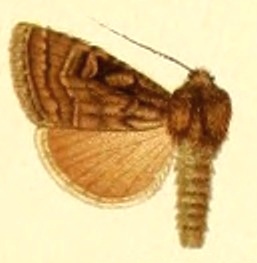| Xestia ornata | |
|---|---|
| Scientific classification | |
| Kingdom: | |
| Phylum: | |
| Class: | |
| Order: | |
| Family: | |
| Genus: | |
| Species: | X. ornata |
| Binomial name | |
| Xestia ornata (Staudinger, 1892) | |
| Synonyms | |
| |
Xestia ornata is a moth of the family Noctuidae. It is found from the northern Tien-Shan Mountains through the Pamirs and Hissar-Darwaz system to eastern Afghanistan (Nuristan).
The wingspan is 32–37 mm.

The Noctuidae, commonly known as owlet moths, cutworms or armyworms, are a family of moths. They are considered the most controversial family in the superfamily Noctuoidea because many of the clades are constantly changing, along with the other families of the Noctuoidea. It was considered the largest family in Lepidoptera for a long time, but after regrouping Lymantriinae, Catocalinae and Calpinae within the family Erebidae, the latter holds this title now. Currently, Noctuidae is the second largest family in Noctuoidea, with about 1,089 genera and 11,772 species. This classification is still contingent, as more changes continue to appear between Noctuidae and Erebidae.

Noctuoidea is the superfamily of noctuid or "owlet" moths, and has more than 70,000 described species, the largest number of for any Lepidopteran superfamily. Its classification has not yet reached a satisfactory or stable state. Since the end of the 20th century, increasing availability of molecular phylogenetic data for this hugely successful radiation has led to several competing proposals for a taxonomic arrangement that correctly represents the relationships between the major lineages.

Xestia is a genus of noctuid moths. They are the type genus of the tribe Xestiini in subfamily Noctuinae, though some authors merge this tribe with the Noctuini. Species in this genus are commonly known as "clays", "darts" or "rustics", but such names are commonplace among Noctuidae. Xestia moths have a wide distribution, though they most prominently occur in the Holarctic.

The Noctuinae are a subfamily of the family Noctuidae, and is composed of moths. The larvae of many species feed on roots or stems of various grasses. Some are generalist feeders which makes them potential pests.
Hadeninae was formerly a subfamily of the moth family Noctuidae, but was merged into the subfamily Noctuinae. The tribes Apameini, Caradrinini, Elaphriini, Episemini, Eriopygini, Hadenini, Leucaniini, Orthosiini, and Xylenini were moved from Hadeninae to Noctuinae.

Eugraphe is a genus of noctuid moths. They belong to the tribe Xestiini of the typical noctuid subfamily Noctuinae, though some do not separate this tribe and include the genus in the Noctuini. It is closely related to Anagnorisma, Coenophila and Eugnorisma, and as it seems most closely to the first of these. The geographic range is Palearctic, north of the Alpides but including the Caucasus, and between the Arctic and the arid lands of Central Asia.

Goniographa is a genus of noctuid moths. They belong to the tribe Xestiini of the typical noctuid subfamily Noctuinae, though some do not separate this tribe and include the genus in the Noctuini.

Goniographa marcida is a moth of the family Noctuidae. It is found endemic to the Kopet-Dagh mountain system in Turkmenistan and Iran.
Goniographa gyulaipeteri is a moth of the family Noctuidae. It is widely distributed in the western Tien-Shan Mountains, in the Hissar and Alai Mountains, in the western Pamirs and also in north-eastern Afghanistan (Badakhshan).
Goniographa decussa is a moth of the family Noctuidae. It is found in the western Tien-Shan Mountains.
Goniographa discussa is a moth of the family Noctuidae. It is found from the Zeravshan Mountains and Hissar Mountains through the western Pamirs to north-eastern Afghanistan (Badakhshan).
Goniographa shchetkini is a moth of the family Noctuidae. It is only known from a single location near the Liangar Glacier.

Goniographa funkei is a moth of the family Noctuidae. It is found in the western Tien-Shan Mountains, the Hissar Mountains and the western parts of the Pamir massif.
Goniographa metafunkei is a moth of the family Noctuidae. It has a strictly limited distribution in the western part of the Tien-Shan Mountains and the Alai Mountains.
Goniographa naumanni is a moth of the family Noctuidae. It is confined to the Hissar Mountains, the western Pamirs and the north-eastern territories of Afghanistan.
Xestia hypographa is a moth of the family Noctuidae. It is only known from the north-western part of the Tien-Shan Mountains.

The Erebidae are a family of moths in the superfamily Noctuoidea. The family is among the largest families of moths by species count and contains a wide variety of well-known macromoth groups. The family includes the underwings (Catocala); litter moths (Herminiinae); tiger, lichen, and wasp moths (Arctiinae); tussock moths (Lymantriinae), including the arctic woolly bear moth ; piercing moths ; micronoctuoid moths (Micronoctuini); snout moths (Hypeninae); and zales, though many of these common names can also refer to moths outside the Erebidae. Some of the erebid moths are called owlets.

Eugraphe sigma is a moth of the family Noctuidae. It is found from most of Europe to the Ural, Siberia, Transcaucasia, Armenia and Korea.
Pseudomiza argentilinea is a species of moth of the family Geometridae first described by Frederic Moore in 1868. It is found in Taiwan, China, Myanmar and India.